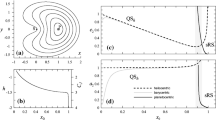Abstract
In a previous paper, we have developed an analytical model of the secular 3D planetary problem by expanding the perturbation function up to the twelfth order in the eccentricities and the inclinations. Although the expansion is limited the model is able to describe with accuracy most of the observed systems of exoplanets. With the help of this model we were able to describe the geometry of the phase space of a typical system. The kernel of this description is a series of surfaces of section showing the chaotic and the regular domains of the phase space. We have observed in this previous paper that a family of unstable periodic orbits is responsible for the chaoticity, while we have hinted that the islands of stability are organized around stable periodic orbits. In this contribution we compute the main families of periodic orbits of the problem and show that indeed they are responsible for sculpting the phase space.
Similar content being viewed by others
References
Callegari, N., Ferraz-Mello, S., Michtchenko, T.A.: Dynamics of two planets in the 3:2 mean-motion resonance: application to the planetary system of the pulsar PSR B1257+12. Celest. Mech. Dyn. Astr. 94, 381–397 (2006)
Deprit, A., Henrard, J.: A manifold of periodic orbits. In: Kopal, Z. (ed.) Advances in Astronomy and Astrophysics, vol. 6, pp. 1–124. Academic Press (1968)
Devaney, R.: Blue sky catastrophes in reversible and hamiltonian systems. Indiana Univ. Math. 26, 247–263 (1977)
Hadjidemetriou, J.D.: Symmetric and asymmetric librations in extrasolar planerary systems: a global view. Celest. Mech. Dyn. Astr. 95, 225–244 (2006)
Henrard, J.: Solution générale au voisinage des équilibres colinéaires du problème restreint. Ph.D. dissertation, Université Catholique de Louvain (1965)
Henrard, J.: Proof of a conjecture of E. Strömgren. Celest. Mech. Dyn. Astr. 7, 449–457 (1973)
Henrard, J.: On Brown’s conjecture. Celest. Mech. Dyn. Astr. 31, 115–122 (1983)
Henrard, J.: The Web of periodic orbits at L 4. Celest. Mech. Dyn. Astr. 83, 291–302 (2002)
Jacobi, C.G.J.: Sur l’élimination des noeuds dans le problme des trois corps. Astron. Nachr. 20, 81–102 (1842)
Jefferys, W.H., Moser, J.: Quasi-periodic solutions for the three-body problem. Astron. J. 71, 568–578 (1966)
Kinoshita, H., Nakai, H.: General solution of the Kozai mechanism. Celest. Mech. Dyn. Astr. 98, 67–74 (2007)
Kozai, Y.: Secular perturbations of asteroids with high inclination and eccentricity. Astron. J. 67, 591–598 (1962)
Laskar, J.: Systèmes de variables et éléments. In: Benest, D., Froeschlé, C. (eds.) Les méthodes modernes de la mécanique céleste, pp. 63–87. Editions frontières, Gif-sur-Yvette (1990)
Laskar, J.: Large scale chaos and the spacing of inner planets. Astron. Astrophys. 317, L75–L78 (1997)
Libert, A.-S., Henrard, J.: Analytical approach to the secular behaviour of exoplanetary systems. Celest. Mech. Dyn. Astr. 93, 187–200 (2005)
Libert, A.-S., Henrard, J.: Exoplanetary systems: the role of an equilibrium at high mutual inclination in shaping the global behaviour of the 3D secular planetary three body problem. Icarus 191, 469–485 (2007)
Michtchenko, T.A., Ferraz-Mello, S., Beaugé, C.: Modeling the 3-D secular planetary three-body problem. Icarus 181, 555–571 (2006a)
Michtchenko, T.A., Beaugé, C., Ferraz-Mello, S.: Stationary orbits in resonant extrasolar planetary systems. Celest. Mech. Dyn. Astr. 94, 411–432 (2006b)
Muñoz-Almaraz, F.J., Freire, E., Galan-Vioque, J., Vanderbauwhede, A.: Continuation of normal doubly symmetric orbits in conservative reversible systems. Celest. Mech. Dyn. Astr. 97, 17–47 (2007)
Poincaré, H.: Méthodes Nouvelles de la Mécanique Céleste, tI. Gauthier Villars, Paris (1892). Reprinted by Blanchard (1987)
Robutel, P.: Stability of the planetary three-body problem. II KAM theory and existence of quasiperiodic motions. Celest. Mech. Dyn. Astron. 62, 219–261 (1995)
Strömgren, E.: Bull. Astron. 9, 87 (1933)
Voyatzis, G., Hadjidemetriou, J.D.: Symmetric and asymmetric 3:1 resonant periodic orbits with an application to the 55 Cnc extrasolar system. Celest. Mech. Dyn. Astr. 95, 259–271 (2006)
Author information
Authors and Affiliations
Corresponding author
Additional information
Anne-Sophie Libert is FNRS Research Fellow.
Rights and permissions
About this article
Cite this article
Henrard, J., Libert, AS. Periodic orbits as centers of stability in the secular 3D planetary three body problem. Celest Mech Dyn Astr 102, 177–189 (2008). https://doi.org/10.1007/s10569-007-9111-8
Received:
Revised:
Accepted:
Published:
Issue Date:
DOI: https://doi.org/10.1007/s10569-007-9111-8




